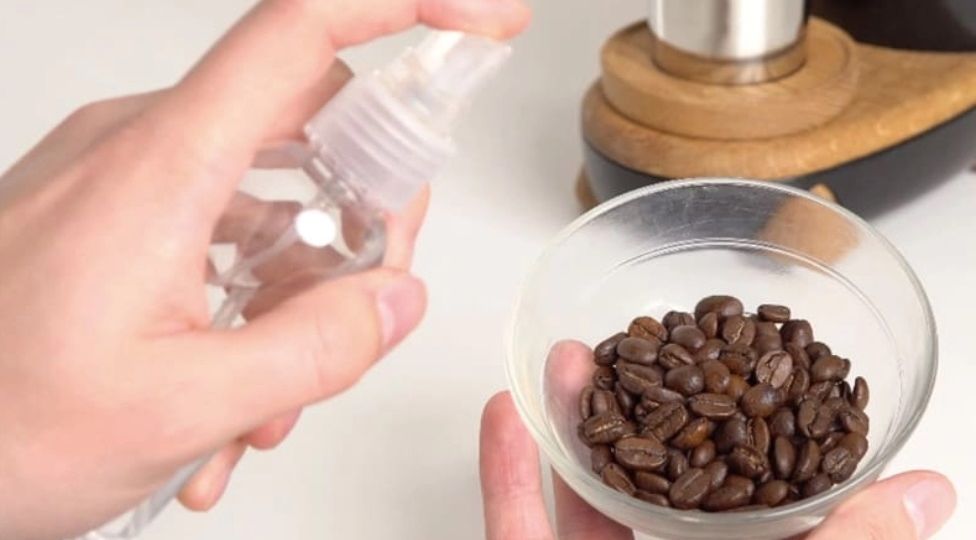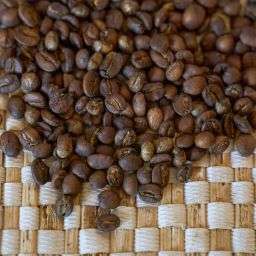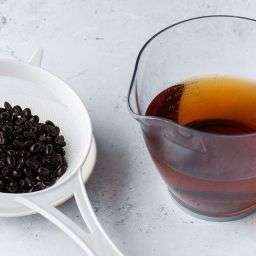
In recent years, the coffee industry has witnessed a surge in innovative practices aimed at enhancing the quality and consistency of home-brewed coffee. One such practice, which has gained considerable attention, involves spraying coffee beans with a fine mist of water before grinding. This method, supported by advancements in coffee machine accessories, including the provision of small spray bottles, aims to elevate the brewing experience.
The technique is not just a passing trend but is grounded in a deeper understanding of coffee bean physics and grinder mechanics. By addressing static electricity and moisture levels, it promises a cleaner, more precise, and enjoyable coffee-making process, appealing to both novices and connoisseurs alike.
Key Takeaways
- Reduction of Static for a Cleaner Grinding Process: Spraying coffee beans before grinding is primarily recommended to reduce static electricity. This reduction in static means fewer coffee grounds stick to the grinder and the surrounding area, leading to a cleaner and more efficient grinding process.
- Improved Brewing Recipe Accuracy by Minimizing Waste: By ensuring that all ground coffee makes it from the grinder to the brewer, this technique minimizes waste and improves the accuracy of brewing recipes. This is crucial for achieving consistent taste and quality in every cup.
- Less Frequent Need for Grinder Maintenance: The accumulation of coffee grounds in the grinder can necessitate frequent cleaning. Spraying beans beforehand reduces the grounds sticking to the grinder parts, thus decreasing the maintenance frequency.
- Importance of Not Over-Wetting the Beans: It’s critical to apply just enough water to mitigate static without adversely affecting the beans’ grindability and the subsequent brewing process. Over-wetting can lead to negative brewing effects, such as uneven extraction.
- The Necessity of Shaking the Beans After Spraying: After lightly misting the coffee beans, shaking them ensures even distribution of moisture. This step is essential for uniformity in grind size and extraction, contributing to a balanced flavor profile.
- Recommendations on Checking Your Grinder and Selecting an Appropriate Spray Bottle: Not all grinders react the same way to moistened beans. Evaluating your grinder’s response to slight moisture can help you decide the necessity of this step. Furthermore, choosing the right spray bottle, one that emits a fine mist, is crucial for applying the perfect amount of water without drenching the beans.
Why Spray Coffee Beans Before Grinding?
The practice of lightly misting coffee beans with water before grinding is a technique that addresses a fundamental challenge in coffee preparation: static electricity. When coffee beans are ground, friction between the beans and the grinder, as well as between the beans themselves, generates static. This static causes the freshly ground coffee to scatter, leading to waste and a messy grinding process. The application of a fine water mist to the beans just before grinding significantly reduces this static, ensuring a cleaner grind and minimizing waste.
The scientific basis for this technique lies in the ability of water to dissipate static charge, thus preventing the coffee grounds from sticking to the grinder and each other. This not only simplifies the cleaning process but also ensures that all the coffee you grind ends up in your brew, enhancing accuracy and consistency in your coffee recipes.
The historical roots of this practice can be traced back to the Ross Droplet Technique, a method named after its inventor. This technique, and its variations, have been explored and refined within the coffee community, including on platforms such as Home-Barista forums.
Coffee experts and enthusiasts have experimented with and embraced this method, recognizing its potential to improve the quality of the grind and, by extension, the brewed coffee. Studies and anecdotal evidence have shown that this simple addition to the grinding process can lead to a noticeable improvement in the taste and aroma of coffee, making it a popular hack among those seeking to elevate their brewing experience.
How to Spray Coffee Beans Before Grinding
Spraying coffee beans before grinding is a straightforward process that requires minimal preparation. Here’s a step-by-step guide to ensure you achieve the best results:
- Gather Your Materials: You will need a fine mist spray bottle and clean, filtered water. The bottle should produce a fine mist to lightly coat the beans without drenching them.
- Prepare the Coffee Beans: Measure out the amount of coffee beans you intend to grind. It’s important to only spray the amount you will use immediately to prevent any potential moisture-related issues with storage.
- Spray the Beans: Hold the spray bottle a few inches above the beans and lightly mist them with water. Aim for one to two sprays, depending on the amount of coffee. The goal is to lightly moisten the surface of the beans without making them wet.
- Shake the Beans: After spraying, gently shake the container or use your hand to stir the beans. This helps to distribute the moisture evenly across all the beans, ensuring a uniform grind.
By following these steps, you can mitigate static electricity during the grinding process, leading to a cleaner and more efficient coffee preparation experience. Remember, the key is to use just enough water to reduce static without affecting the grinding and brewing process adversely.
Benefits of Spraying Coffee Beans
Spraying coffee beans before grinding offers several benefits, enhancing the overall coffee-making experience. Each of these advantages contributes to a smoother process and a superior final product.
- Reduced Static: The primary benefit of spraying coffee beans is the significant reduction in static electricity generated during grinding. Static causes grounds to scatter and stick to the grinder and surrounding areas, making clean-up tedious and leading to waste. A light mist of water neutralizes static, ensuring that grounds fall neatly into the container, thereby reducing mess and waste.
- Greater Brewing Recipe Accuracy: By minimizing the scattering of coffee grounds, this technique ensures that the exact amount of coffee intended for brewing is used. This precision is crucial for consistent brewing, as even minor variations in coffee quantity can alter the taste and strength of the brew. Accurate dosing leads to more consistent and repeatable results, making each cup of coffee as enjoyable as the last.
- Less Grinder Maintenance: Coffee grounds sticking inside the grinder necessitate frequent cleaning to maintain optimal performance and prevent flavor cross-contamination. The moisture introduced by spraying the beans binds the grounds together and reduces static, decreasing the amount of residue that clings to the grinder’s interior. This results in less frequent need for cleaning and prolongs the life of the grinder.
Potential Drawbacks and How to Avoid Them
While spraying coffee beans presents numerous benefits, there are potential drawbacks that one should be aware of. Here’s how to mitigate these issues:
- Uneven Moisture Distribution: To avoid uneven moisture, which can lead to inconsistent grinding and extraction, ensure you shake the beans after spraying. This helps distribute the water evenly.
- Risk of Over-Moistening: Over-moistening can lead to clumping and impact the flavor negatively. Use a fine mist spray bottle and limit yourself to one or two sprays to prevent this.
- Extended Grinding Time: The added moisture can make beans slightly tougher to grind. To counteract this, adjust your grinder settings if possible, to accommodate the slight change in bean texture.
- Impact on Grinder Maintenance: While spraying reduces the need for frequent cleaning, moisture introduction requires ensuring the grinder is dried well after use to prevent rust or mold. Regular maintenance and occasional deep cleaning can mitigate these risks.
- Varied Impact on Flavor: Some coffee enthusiasts find that spraying enhances the flavor, while others notice minimal difference. Experiment with and without spraying to determine your preference and adjust the amount of water used accordingly.
By being mindful of these potential drawbacks and applying the recommended precautions, you can enjoy the benefits of spraying coffee beans without negative side effects, optimizing your coffee grinding and brewing process for the best possible taste and experience.
FAQs
Does spraying affect grinder performance?
No, spraying coffee beans before grinding does not negatively affect grinder performance. In fact, it can enhance performance by reducing static and minimizing grounds sticking to the grinder parts, thereby requiring less frequent cleaning.
Can I use alternative liquids for spraying?
While water is the most common and recommended liquid due to its neutral impact on flavor and grinder safety, some individuals experiment with using brewed coffee or espresso to enhance flavor. However, it’s crucial to use any alternative liquid sparingly to avoid negative effects on the grinder or the coffee’s taste.
Do I need a special grinder for sprayed beans?
No special grinder is required for beans that have been lightly misted with water. Standard grinders can handle the slight moisture increase without any issues, and you may even notice an improvement in grind consistency and flavor extraction.
Final Thoughts
Spraying coffee beans before grinding is a simple yet effective technique that can significantly enhance the coffee brewing experience. By reducing static, ensuring greater recipe accuracy, and necessitating less grinder maintenance, this practice addresses common challenges faced during the coffee preparation process.
While there are potential drawbacks, such as uneven moisture distribution and the risk of over-moistening, these can be easily mitigated with careful application and a little experimentation. We invite coffee enthusiasts to explore this technique in their brewing routines, experimenting with the amount of moisture and observing the impact on flavor and grind consistency. Embrace the opportunity to refine your coffee-making process, and enjoy the journey towards crafting the perfect cup of coffee.









